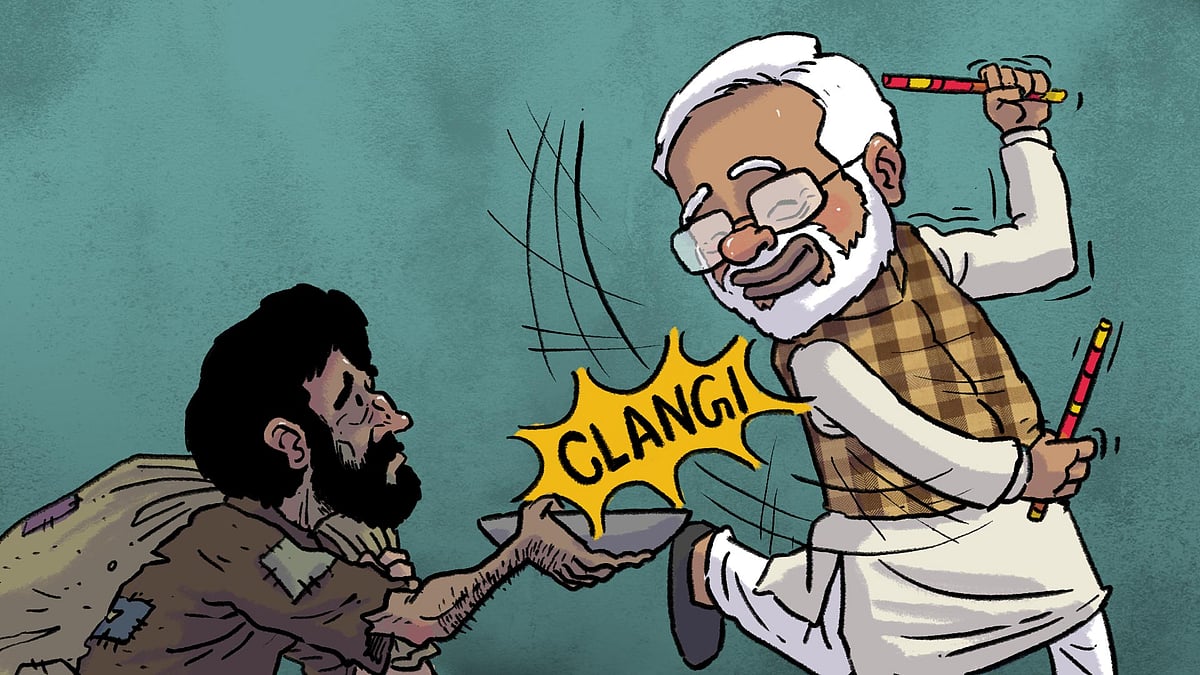Coronavirus, social distancing, and the return of caste apologists
Imagery and language used to popularise measures necessary for tackling the pandemic have sparked attempts to peddle ‘scientific reasons’ for untouchability.
On March 24, Prime Minister Narendra Modi declared that India would go into lockdown for three weeks to tackle the coronavirus pandemic. The aim is to minimise contact between people as experts have established that “social distancing” is the most effective way to contain the spread of the highly contagious virus. In his speech, the prime minister emphasised that there “is no other way to escape” the pandemic than social distancing.
In the days since, social media has been abuzz with discussions about the importance of social distancing in slowing down the spread of the novel coronavirus. Amid these discussions have emerged some muffled yet worrying voices equating social distancing with caste practices that have plagued social relations in India for centuries.
Kerala specifically has a history of oppressive notions of purity and pollution which resulted in not just the practice of untouchability, but also unapproachability and ‘unseeability’.
When these practices started to crack in the nineteenth century, there were similar attempts of “justifying” caste atrocities in the name of hygiene. But such attempts were quickly suppressed by the reform movement on the one hand and the practical impossibilities of the market system on the other.
Today, when the market has vastly expanded and religion has been reintroduced into the public sphere, caste has again reared its ugly head in popular discourse. It is in this context that discussions on “social distancing” and caste need to be read.
Ambika JK, a social media user with a considerable following, put up a Facebook post last week equating social distancing with ayitham, or untouchability; sanitisation with theendal, or unapproachability; and quarantine with pula, a ritual of pollution observed for a certain period after events such as death. She argued that unapproachability, untouchability and the laws of pollution were “scientific”, and that they promoted purity and hygiene for the benefit of society as a whole. Social distancing enforced by the coronavirus pandemic, she concluded, was “time...taking its revenge” against the communists who, in a desperate attempt to modernise Kerala, had turned their back on Hindu heritage.
The post was “liked” by around 3,000 Facebook users within three days, and shared by over 2,000. In a veiled response, VT Balram, a Congress legislator, asked that people who shared such a view should take their “feudal romanticism” elsewhere, noting that even in pre-modern times, epidemics killed thousands of people in Kerala, mostly from the “lower castes”.
But posts drawing “similarities” between social distancing and the caste system have continued to appear, including on Whatsapp groups.
Such discussions take Kerala back a hundred years, when attempts to justify the caste system by equating it with hygiene were first made. Untouchability, unapproachability and unseeability, lest there is any doubt, were nonconsensual practices of sociospatial control, and had little to do with hygiene or sanitation.
Searching for justifications
In the nineteenth and early twentieth centuries, progressive thinkers emerged in Kerala who led the questioning of the archaic laws of social relations that had continued unabated for centuries. These people came either from the section of population with access to modern education — and, with it, the philosophical endeavours of European modernity – or from communities which had started to assert themselves in spaces previously closed to them, such as roads, roads and, eventually, temples. Many of them were influenced by social reform movements that had emerged under Sree Narayana Guru, Ayyankali, Poykayil Appachan, Velayudha Panikkar, Sahodaran Ayyappan, among others.
In response, a section from among caste Hindus quickly attempted to find “scientific explanations” for the caste system. They tried to propagate the notion that the “lower castes” deserved lower social status because of arbitrary definitions of hygiene. In 1909, for one, the Cochin Tribes and Castes Report, compiled by a Tamil Brahmin, characterised Pulayan as someone whose “hair is allowed to grow wild and forms an immense matted filthy mass”. Their habitations, it added, were “deficient in ventilation and the air is always more or less foul”.
In 1910, a local newspaper in Travancore reported a controversy over separate seating arrangements for Dalit Christians and upper caste Christians. When restaurants and coffee clubs started to appear in Kerala during this period, Kanippayyur Sankaran Namboodiripad writes in his memoirs, that there were separate ones for Brahmins and non-Brahmins, and that Brahmin hotels run by Nambuthiris, Tamil Brahmins or Saraswat Brahmins were considered more clean and hygienic. There was “no need for a signboard to help differentiate a Brahmin Coffee Club from a non-Brahmin one. However, most Brahmin places would still have a board outside stating it. A container and a davara made of brass, clay or steel was used until recently in Brahmins hotels, and not glass tumblers”.
Although he does not specify what the distinctions were based on, the implicit assumption is that some coffee shops were more hygienic by virtue of their nobility. The introduction of a steel davara – a small container that came with the tumbler and was used to cool the coffee or drink it from – was an attempt to maintain the laws of pollution as coffee culture spread in South India, as historian AR Venkatachalapthy notes in his essay, In Those Days There Was No Coffee.
Such efforts at citing cleanliness as a marker of caste difference received some impetus in the late 1920s, when initiatives led by the Congress to reach out to the Harijans stressed that the reason for their low status was lack of cleanliness. Clearly, it was an attempt to argue that the rules of purity and pollution based on the senses of sight and touch had more than merely a religious element; it was an attempt to find “scientific explanations” for exclusion to suit their purposes.
By the 1930s, however, these attempts had failed for two reasons. One was economic. The modern spaces – restaurants, public transport, libraries – had become difficult to sustain as exclusionary ones. Given the limited market size, they had to open up to become profitable; it was unviable to operate without employing lower caste members. Kanippayyur points out that the Brahmin restaurants needed people to do work that orthodox Brahmins refused to, and this created practical difficulties. Though some attempts were made to have separate sections for Brahmins and the rest in restaurants and on public transport, they eventually failed.
Meanwhile, social reformers such as Narayana Guru emphasised the importance of hygiene and education for the uplift of society. Soon, early communists realised that they needed to engage closely with people from across castes to win their trust. They took to visiting the homes of people from the “lower castes”, and sharing their water and gruel in an effort to bust the myths of hygiene and pollution. Once class replaced caste as the “natural” alternative for social divisions, the unresolved contradictions were put aside under the assumption that they would automatically be resolved once class inequality was dealt with.
Social distancing and caste
The return of caste to the public sphere has been a matter of much concern in the recent past in Kerala. It is in this context that the ongoing attempts of using “social distancing” as a justification for the caste system need to be addressed.
At least part of this narrative seems to emerge from the visual imagery and language that has come to be associated with battling the pandemic. In a society like ours, the word “social distancing” is easily misconstrued to mean distancing based on social differences. It runs the risk of letting people with narrow interests equate a practical strategy to fight the spread of a virus by staying apart to stay together, with the exclusionary practices enforced by one section of society to dominate another. In fact, having seen the limitations of using the term “social distancing” even in the West, the World Health Organisation has suggested that it be replaced with “physical distance, social unity”.
The Kerala government has already made the necessary change in the narrative and language around social distancing. At one of his routine press conferences last week, Chief Minister Pinarayi Vijayan reiterated, “Physical distance, social unity – that should be our slogan at this time.” His use of “guest labourer” in place of “migrant worker” has also received appreciation.
It is still early to estimate the economic damage of the coronavirus pandemic, but its social costs have already been laid bare. Dailywage earners, migrant labourers, waste pickers, and sanitation workers have borne the brunt of the pandemic. Steps taken by the Kerala government to ensure the livelihoods of people from disadvantaged sections are protected is a welcome move to reduce these social costs.
Meanwhile, narrow-minded pronouncements by attention-seeking social media “influencers” need to be nipped in the bud before they add fuel to the fire already lit by apologists of the caste system.
S Harikrishnan is a PhD in political science from Dublin City University, Ireland. He co-edits Ala, a Kerala studies blog.

Support Independent Media
The media must be free and fair, uninfluenced by corporate or state interests. That's why you, the public, need to pay to keep news free.
Contribute Why India doesn’t seem to care about its poor even during a pandemic
Why India doesn’t seem to care about its poor even during a pandemic Social distancing: What it is and why it’s the best tool we have to fight the coronavirus
Social distancing: What it is and why it’s the best tool we have to fight the coronavirus
Power NL-TNM Election Fund
General elections are around the corner, and Newslaundry and The News Minute have ambitious plans together to focus on the issues that really matter to the voter. From political funding to battleground states, media coverage to 10 years of Modi, choose a project you would like to support and power our journalism.
Ground reportage is central to public interest journalism. Only readers like you can make it possible. Will you?
